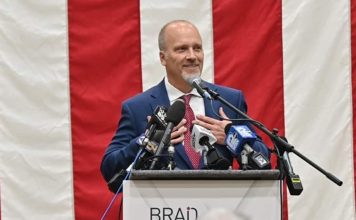This article was reprinted with permission from the MacIver Institute. You can read the original here.
- Minutes after new liberal majority take control of Wisconsin Supreme Court, a lawsuit was filed to overturn legislative maps
- Current maps withstood judicial review
- Democrat Evers’ Congressional maps give larger advantage to GOP than their own maps
Just hours after Justice Protasiewicz was inaugurated, left-leaning groups filed an original action petition asking the Supreme Court to throw out the current legislative maps and redraw the lines based on provisions in state law.
The case was expected and comes about a year and a half after the current maps were put in place. Let’s do a quick recap of how we got here.
Current State of Wisconsin Maps
As it turns out, it’s hard to draw maps in Wisconsin that do not give a heavy advantage to Republicans. Much of the rhetoric used by the left about why the maps are so unfair isn’t grounded in an understanding of the geography and demographics of the state.
Governor Evers created the “People’s Maps Commission” as a vehicle for his appointees (the public, and sciencey and mathy folks) to draw maps that would finally stick it to Republicans and take back power.
Only it didn’t work that way.
The “People” drew a number of maps. From scratch. The closest they got to their goal was to give Republicans a 55-44 advantage in the Assembly. Their maps were slammed by Democratic lawmakers as illegal, unfair, immoral, and wrong.
The preceding gubernatorial election was decided by a point. The liberal talking points insist that the close statewide election means the legislature should be split by such razor thin margins as well.
But the congressional maps ultimately drawn by Democrat Evers created a 75%-25% split in favor of Republicans while the GOP drawn legislative maps create a 65%-35% split.
It’s next to impossible to draw Republicans out of legislative majorities because there are a lot of Republican voters across the state, while Democrat voters tend to be concentrated in urban areas. Drawing districts to split up those urban blocks requires ignoring some of the main requirements for districts – compactness, contiguity, preserving political subdivision boundaries and communities of interest.
Brief Timeline
November 2021: Congressional and legislative maps passed by GOP legislature vetoed by Evers.
November 2021: Wisconsin Supreme Court ordered that it would utilize the ‘least change’ approach, pushed by Republicans, to choose maps.
March 2022: Wisconsin Supreme Court selected Evers’ maps as best adhering to the ‘least change’ criteria moving the fewest voters between districts.
March 2022: US Supreme Court: Reversed the selection of Evers’ legislative maps; left the congressional maps in place.
April 2022: Wisconsin Supreme Court selected GOP legislative maps to replace the Evers maps that were struck down by SOCTUS.
April 2023: Janet “the maps are rigged” Protasiewicz is elected to the state Supreme Court, setting up a liberal majority.
August 2023: Protasiewicz sworn in; new petition filed challenging constitutionality of maps.
Federal and State Redistricting Requirements
The US constitution requires congressional districts be as equal in population as possible, and state legislative districts be substantially equal. Maps may not discriminate on the basis of race and dilute the minority vote. Wisconsin has no statutory or constitutional guidelines regarding congressional redistricting but does require legislative districts to be compact, contiguous, preserve political subdivisions and preserve communities of interest. (There is no requirement that districts contain the “least change” which is the standard the SCOWI used when choosing the Evers maps in early 2022.)
Past Comments From Members Of The Liberal Majority Members Of The Court
To the extent that past pronouncements carry any weight, particularly among this group of jurists, here are some of their past remarks on redistricting taken from their written opinions and public comments.
Jill Karofsky – “I hope that we will permit a politically insulated federal court to manage the task. Federal courts are better able to conduct extensive fact-finding through trial-style litigation, a task for which we proved ill-equipped”
Rebecca Dallet – “How are we going to do fact finding?…We have a statute that allows for the fact finding. It allows us to appoint circuit court judges or even appellate court judges to handle the fact finding. But we {the full court} didn’t follow that statute. And we could also have at that point done what other states do and commissioned someone to help us draw the maps, right. Someone like Stanford professor Nate Persily…But instead we decided that we would treat this like we were ordering off a menu…”
Ann Walsh Bradley – “I joined the dissent from the order granting the {2021 original action} petition due to the myriad ‘reasons for preferring a federal forum’ and because this court had ‘no experience in drawing district maps.’”
Janet Protasiewicz – “The maps are rigged…I don’t think you could sell any reasonable person that the maps are fair. I can’t tell you what I would do in a particular case, but I can tell you my values, and the maps are wrong.”
Protasiewicz also told the New York Times in April that it was unlikely the court could decide a case and put new maps into effect by the 2024 elections.
Both Karofsky and Walsh Bradley reference preference for federal court involvement, but the petition filed yesterday has been crafted to address only issues of Wisconsin constitutionality. It’s relatively clear that the court will look for outside help to draw the maps for them, ill-equipped and inexperienced as they see themselves.
Top on their list will almost certainly be the aptly named Princeton Gerrymandering Project, whose director was falling over himself on social media in the days before Protasiewicz’s election to give advice to the new liberal majority he was hoping to see on how to “un-gerrymander” Wisconsin.
Wang is such a fanboy that he retweeted a photo of the Protasiewicz inauguration ceremony.
We wrote extensively about Wang and the charges of harassment from staff – and more relevant to the coming maps – allegations by staff that he cooked the numbers to favor Democrats. Wang’s phony math was used to give F grades to Republican maps, including Wisconsin’s.
A few days later – this guy is interviewing hard for the consulting gig the liberal left on the court will be dishing out – Wang was on former Democratic state senator Pat Kreitlow’s radio show sharing the blueprint for undoing the “rigged” maps. Among his advice to the litigants and the court:
Don’t cite the Voting Rights Act
Use only state laws not federal laws
Swap Wisconsin law in for arguments from the SCOTUS case – Roberts’ due process and equal protection arguments and Kagan’s on viewpoint discrimination and freedom of speech
Use research (like his, natch) to develop boundaries that maintain communities of interest, then move to arguments about equal protection and freedom of association but only citing state law
Be willing to draw maps
Don’t worry about the Independent State Legislature Doctrine because it does not apply to state elections.
Wang also points out the high number of split counties and the conflict with our state requirements.
Wang’s work in New Jersey is what blew up accusations and revelations about PGP. Princeton received complaints that Wang was deliberately manipulating data to achieve the outcome he wanted. One source said:
“He’d fudge the numbers to get his way. He had an agenda. He was good at hiding it when he had to but it was clear Sam wanted Democrats to win and he was willing to cheat to make it happen.”
Does the Petition Filed Wednesday Follow Wang’s Blueprint?
Check, check, check, and check.
Wang’s advice seems to have been central to shaping the case filed yesterday; they do not cite the VRA, they use only state laws, they focus on the arguments he suggests. The petition claims the current maps:
Violate our constitution’s equal protection guarantee
Violate our constitutional free speech guarantee
Abridge our constitutional right to free association
Violate express constitutional requirements for contiguous districts
Require the court to order new maps drawn
What’s Next
We know what Janet and the rest of the liberal majority will do on the redistricting case. It is a strong bet we will see Wang and/or Sachin Cheda (formerly of Fair Maps Wisconsin who recently and mysteriously left all his places of employment), to be brought on by the new SCOWI to create new gerrymandered maps to favor Democrats. Wang likely has a set ready.
All we really aren’t sure of is where the new lines will be or how many requirements they’re willing to trample in order to gerrymander the state to benefit Democrats.











![WATCH: Elon Musk Town Hall Rally in Green Bay [FULL Video]](https://www.wisconsinrightnow.com/wp-content/uploads/2022/04/Elon_Musk_3018710552-356x220.jpg)



![The Wisconsin DOJ’s ‘Unlawful’ Lawman [WRN Voices] josh kaul](https://www.wisconsinrightnow.com/wp-content/uploads/2025/03/MixCollage-29-Mar-2025-08-48-PM-2468-356x220.jpg)







![Phil Gramm’s Letter to Wall Street Journal [Up Against the Wall]](https://www.wisconsinrightnow.com/wp-content/uploads/2025/03/gramm-356x220.png)










